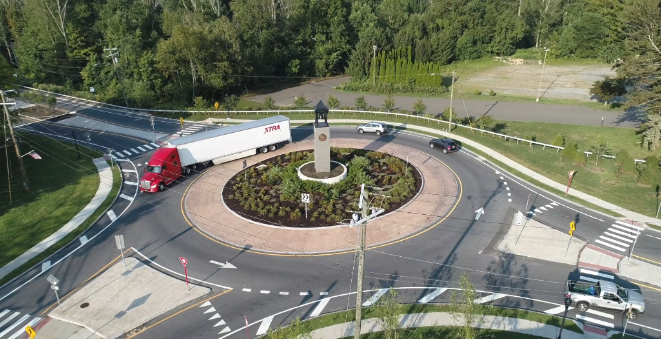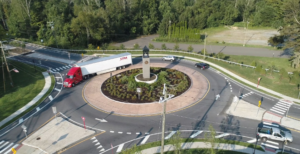Officials at every level of government are committed to making roadways safer for vehicles, bicyclists, and pedestrians. The enthusiasm along with available funding is restructuring roadways throughout the country. Contracting firms of every type will be in high demand as roadway infrastructure undergoes a massive change in the next several years.
Federal funding programs that support road safety have either been created or expanded. Earlier this year, the Federal Highway Administration (FHWA) released guidelines for its Highway Safety Improvement Program’s formula grants following an injection of $4 billion in additional funding from the Bipartisan Infrastructure Act.
Another $5 billion in the Safe Streets and Roads for All competitive grant program also allocated funding. The impetus for road safety projects has never been higher.
Vision Zero plans that seek to eliminate traffic fatalities within a certain timeframe are evident in most states. The mayor of New York City recently announced that the city would be investing an additional $3 billion in its upcoming slate of Vision Zero-related projects.
In the state of New Jersey, Hoboken, and Jersey City have implemented safety improvements on a smaller scale. Columbus, Ohio, and Nashville, Tennessee, are now embarking on their own localized Vision Zero plans.
Roadways of every size and type are changing with new safety standards. Projects that only create raised medians are noted for reducing turning crashes by 78 percent and total injury crashes by 95 percent.
Traffic sensors that gauge future road safety needs and monitor effectiveness of current strategies are becoming common in roadway construction. As a result, these trends are leading to an increasingly wide range of road safety-related opportunities.
The Michigan Department of Transportation will prioritize safety as it rebuilds a 2.2-mile section of the Grandview Parkway. The project’s safety components include restoration of pavement, upgraded traffic signalization, improved drainage (with new curb, gutter, storm sewer, culverts, and outlets along the road), paths for alternative transportation, and additional operational enhancements. The project is designed to make the highly trafficked road safer, more convenient, and more comfortable for non-motorized forms of transportation.
A $150 million project in Portland, Oregon will include approximately $40 million for safety components alone. The project is in the design phase. Included are features such as enhanced crossings, increased lighting, signalization improvements, wider sidewalks, lower speeds, enhanced transit priority treatments, and proposed right-of-way changes. A noticeable change of these right-of-way requirements is more sidewalk space for pedestrian use.
The counties of Floyd and Clark, Indiana are anticipating a project that will launch soon to improve safety and mobility along part of Interstate 64. The plan will bring better water drainage, new guardrail installations, updated signage, improved pavement markings, additional lighting, rehabilitated bridges, and new bridge construction to this stretch of interstate. The plan also involves eliminating left-hand ramps and adding new lanes to the interchanges.
A safe roads project in Norwich, Connecticut is projected to cost about $20.4 million for just phase one. The project will be designed to improve safety along Route 82, a roadway that locals refer to as “crash alley.” Efforts to minimize the severity and frequency of collisions will extend across two phases of work. The first phase includes new single-lane roundabouts and a raised median. Subsequent work will be scoped for enhanced pedestrian safety, better bicycle access, and new streetscaping features.
Franklin County, Ohio will be the home of a smart lane project that is expected to cost about $48.5 million. The innovative traffic management solution will improve safety and reduce congestion along Interstate 71. A smart lane in each direction of I-71 will enable the existing roadway shoulders to serve as an additional traffic lane during hours of peak congestion. During off hours, the smart lane will be reserved for emergency responders and maintenance crews to ensure more effective and responsive public safety services. Smart lane projects depend on a network of technology assets such as new camera systems, motion sensors, variable speed limit signs, and large digital message boards to communicate changing traffic conditions to motorists.
Citizens in Lampasas County, Texas will be gifted with a project to widen a segment of U.S. 183. The project, designed to improve safety, will provide additional travel lanes, a “flush” median to divide the lanes, a new center-turn lane, improved shoulders, upgraded culverts for better drainage, and reduced steepness of ditches along the corridor.
A $38 million project in Salt Lake County, Utah will focus on making a prominent roadway safer for motorists and recreational users alike. Mill Creek Canyon Road will be upgraded with many safety components. Safety risks such as deteriorating pavement, inconsistent width of roadway, lack of infrastructure for non-motorized users, unauthorized roadside parking, and erosion due to improper stormwater drainage will all be targeted. The project calls for new crosswalks, guard rail installations, pavement restoration, new parking options, enhanced bicycle access, and upgraded stormwater drainage.
America’s roadway infrastructure is being repaired, enhanced, and made much safer for all citizens. The ongoing efforts will result in boosted economic development, job creation, greater global competitiveness, and safer travel for citizens.








